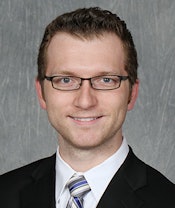
Radiologists say they're working more hours and expect to retire later than they'd prefer, according to a new study published in Academic Radiology. How they handle their exit from the workforce will have major ramifications for future job prospects for radiologists.
The overall radiology job market has varied widely over the past two decades, hitting extremes of both surplus and shortage, and correcting these imbalances can take several years, wrote researchers from Henry Ford Hospital in Detroit. Two consecutive hiring surveys conducted by the American College of Radiology (ACR) Commission on Human Resources found that current demand for radiologists almost exactly matches the number of new trainees entering the workforce, according to lead author Dr. Andrew Moriarity and colleagues.
 Dr. Andrew Moriarity from Henry Ford Hospital.
Dr. Andrew Moriarity from Henry Ford Hospital.But this could change: How radiologists handle work hours and retirement will influence whether there are too many or too few radiologists in the next 15 years.
Boom and bust
Radiology has experienced periods of severe boom and bust over the past two decades, the authors noted. A surplus of radiologists was predicted in 1996, but it turned into a shortage by 2001 that was expected to last for the next 30 years. However, the number of available jobs fell by almost 30% in 2002 and 2003.
The job declines have been exacerbated by major jumps in radiologist productivity, with a 15% increase in volume and a 22% increase in relative value units from 2000 to 2003, followed by steady productivity growth.
To get a better handle on the future job market for radiologists, the researchers surveyed practicing radiologists who are members of the ACR, the Association of University Radiologists, or the Society of Chairs of Academic Radiology Departments. Participants were asked about their current and preferred work level and expected retirement age. The researchers then created a model that incorporated this information, stratified by age, with American Medical Association full-time employment (FTE) data from 2011 to estimate FTE preferences for 2016 through 2031 (Acad Radiol, August 2014, Vol. 21:8, pp. 1067-1071).
The study included 1,840 surveys; 76% of survey participants were male and 24% were female. Moriarity and colleagues divided participants into the following age groups:
- The Veteran generation, born 1925-1945 (12% of those surveyed)
- The Boomer generation, born 1946-1963 (45% of those surveyed)
- Generation X, born 1964-1980 (40% of those surveyed)
- Generation Y, born 1980-2000 (3% of those surveyed)
The researchers calculated preferences under four different scenarios, based on each respondent's current work habits and expectations of retirement:
- Work at current rate and retire when they expect to retire
- Work at desired rate and retire when they expect to retire
- Work at current rate and retire when they would like to retire
- Work at desired rate and retire when they would like to retire
The model Moriarity and colleagues developed estimated a total of 26,362 FTE radiologists available in 2011, which matched previous estimates. Survey participants reported working more hours and expecting to retire later than desired, and younger radiologists and women reported the greatest desired decrease in FTE hours worked.
| Radiologist work-hour preferences by gender and age | |||
| Gender | Period born | Current percent effort FTE | Desired percent effort FTE |
| Female | 1925-1945 | 77.65% | 74.38% |
| 1946-1963 | 91.01% | 77.48% | |
| 1964-1980 | 91.30% | 77.76% | |
| Male | 1925-1945 | 77.24% | 69.15% |
| 1946-1963 | 95.54% | 83.09% | |
| 1964-1980 | 99.48% | 94.00% | |
Under the scenarios, FTE availability in 2016 would range from 21,156 to 24,537 radiologists, representing a 7% reduction compared with the number of working FTE radiologists in 2011, the researchers found. This would also represent a shortage in light of predictions of an 18% increase in demand for radiology services by 2025, they noted.
The shortage would be even more severe if radiologists reduced their current FTE levels to their desired rate and retired when they wanted: Estimated available FTEs would drop by almost 20% compared with 2011 and would not surpass that baseline year until 2030.
What will actually happen? That depends on many external factors, Moriarity told AuntMinnie.com.
"If radiologists continue to work more than they'd like and retire later, the shortage of radiologists will be more subtle in the coming years," he said.




















